Antennas are always fascinating, with lots and lots of options from homebrew to buy it off the shelf. Then there’s six meters, the Magic Band, where the antennas are small enough to fit in your backyard or even your attic. I’ve tried a few along the way. Here’s the rundown.
Six Meter Dipole
 What’s not to like about a six-meter dipole? It’s simple and easily built. Roughly 9 feet from tip to tip, it can fit almost anywhere. It is horizontally polarized, which purportedly is best for VHF DX. And, it works.
What’s not to like about a six-meter dipole? It’s simple and easily built. Roughly 9 feet from tip to tip, it can fit almost anywhere. It is horizontally polarized, which purportedly is best for VHF DX. And, it works.
My write-up on my efforts at Six Meter Dipole has been the post with the most traffic on this website since it was published in 2014. So it must be a popular option as well. I’ll also note that I’ve worked Argentina and Uruguay using that dipole and 100 watts.
Six Meter Vertical

Here my experience has been surprising given the prevailing wisdom that you must be horizontally polarized for VHF DX. I would imagine that is true above six meters. But my own experience has been eye-opening.
In 2011 I purchased a Cushcraft MA6V vertical that covers 20 to 6 meters. This added to my HF contest capabilities. Here’s my blog post HF Verticals. I avoided using this antenna on six since at first I had the dipole and later a Moxon followed by a 3-element Yagi.
But, over the past few years, the only antenna I had was the vertical. So I started working stations on FT8 and to my surprise, they answered. That included Scotland, my first European six-meter contact. I will note that the MA6V is an offset center-fed vertical dipole. And mine is mounted at roughly 20 feet above the ground.
So, a vertical is worth trying on six meters. Plus, it’s easier to fit into the yard.
Six Meter Stressed Moxon
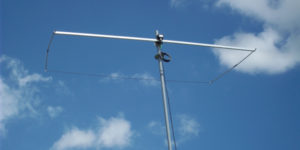 Moxon’s are my favorite type of antenna. My first experience was with a homemade 15-meter version that snagged lots of QSOs for my single-band contest entries. The advantages of these antennas are directional, good front-to-back, and smaller than a Yagi. With the tips of the driven element and reflector bent to nearly touch, it squeezes the width of the antenna into a much smaller space. I’ve posted a 15-meter Moxon video too.
Moxon’s are my favorite type of antenna. My first experience was with a homemade 15-meter version that snagged lots of QSOs for my single-band contest entries. The advantages of these antennas are directional, good front-to-back, and smaller than a Yagi. With the tips of the driven element and reflector bent to nearly touch, it squeezes the width of the antenna into a much smaller space. I’ve posted a 15-meter Moxon video too.
The Par Electronics Stressed Moxon brings this compact design to six meters. It works great with good gain, sound front-to-back rejection, and incredible construction. I’ve used it for years at home on a push-up mast and more recently on my rover operations. It can hit a tree and be bent back into shape for the next grid stop — don’t ask me how I know.
While the gain isn’t as great as the multi-element Yagis, I like that its broader beamwidth covers a lot of ground without needing to tweak the rotator. That works great for contests when the band is open.
This is easily my favorite six-meter antenna.
Six Meter Yagis — 3 Elements
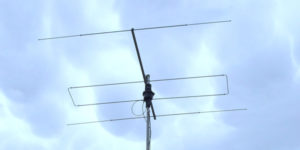 Next up in my six-meter antenna journey was trying to find a bit more gain while still fitting the antenna into my yard. I did a fair bit of review of the available options and selected the InnovAntennas 3-element LFA. Click the link to learn more about my experience. It works nicely and offers reduced noise, although I wasn’t able to discern much difference.
Next up in my six-meter antenna journey was trying to find a bit more gain while still fitting the antenna into my yard. I did a fair bit of review of the available options and selected the InnovAntennas 3-element LFA. Click the link to learn more about my experience. It works nicely and offers reduced noise, although I wasn’t able to discern much difference.
I used that antenna for quite some time. The construction is rock solid but sitting up there on top of a push-up mast along with the rotator, made me pretty nervous in the high winds that sweep through from time to time. So, after a while trying to discern a big difference with the Moxon, I put the Moxon back on the push-up mast.
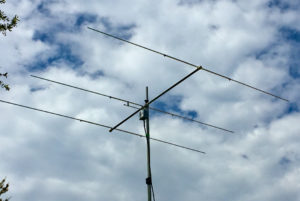 Recently, I’ve purchased an M2 6M-3SS Yagi. Click on the link to learn more. My motivation here was to find a higher gain antenna than the Moxon for use on a temporary installation with a push-up mast in my backyard. I use this for the Summer Es season. Plus, I often use it during rover operations in the CQ WW VHF Contest where I only activate a couple of grids.
Recently, I’ve purchased an M2 6M-3SS Yagi. Click on the link to learn more. My motivation here was to find a higher gain antenna than the Moxon for use on a temporary installation with a push-up mast in my backyard. I use this for the Summer Es season. Plus, I often use it during rover operations in the CQ WW VHF Contest where I only activate a couple of grids.
Given that temporary use, I wanted a Yagi that could be easily taken apart and put back together again for transport and storage. I also wanted a lightweight antenna for use on the push-up mast. This one fits the bill nicely and I’ve already worked several new DXCC countries in Europe and South America from my backyard installation. The LFA would not have worked in this application as it is heavy and a fairly complex build. It’s better for a permanent installation.
Six Meter Omniangle
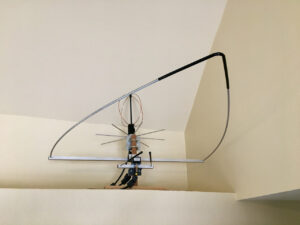
My first use of the Par Electronics Omniangles was on two meters and 70 cm. They worked great to get me started on those higher bands, plus they offered horizontal polarization. Of course, I later added cheap Yagis, Diamond Yagis, and now Directive Systems Rover Yagis for those bands. You just can’t have enough antennas.
Recently I’ve added the six-meter Omniangle positioned in the alcove over my ham shack. I haven’t done too much with the antenna yet. Its purpose is to provide a six-meter antenna during the winter when my temporary push-up mast Yagi installation is in storage.
I like the concept with true omnidirectional coverage and am fascinated by the concept of stacking a couple to achieve some gain. I’ll need to report later on my results here.
There are Always More Options
There is always one more type of antenna to try out, no matter how many you’ve worked within the past. For example, quads have always been on my list.
I hope my experience with six-meter antennas can help you get started down this path or perhaps confirm some of your own experiences. Good luck with your antenna journey on the Magic Band.
Jon Jones, N0JK, editor of QST’s World Above 50 MHz column, sent me these additional comments about his experience with six-meter antennas. Thanks, Jon.
Speaking of more options. I’ve added a Directive Systems 5-element Yagi for use at home and when activating a few relatively rare grids. There’s always more aluminum to add.
24-July-2021
I’ve taken some photos of the current crop of 6-meter antennas in my possession. They include me in the photo to give you a better idea of the size of each of the antennas. They all work, some better than others. But it also doesn’t take much when the band is open.
Mouseover for the caption. Click for a full-size image.
29 March 2022
There’s also a great YouTube video of a presentation by Frank, W3LPL, covering 6 meter Yagi Antenna Systems. Here’s the link https://youtu.be/oLsmwzJfId8
29 December 2023
For still more information, check out my write-up on using EZNEC to determine antenna patterns and gain at EZNEC Antenna Modeling.


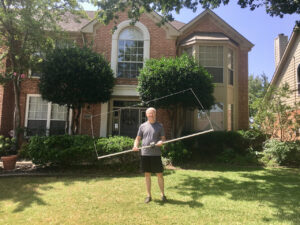
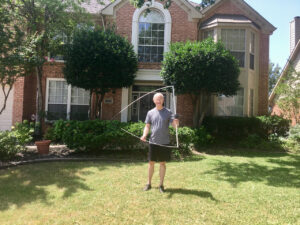

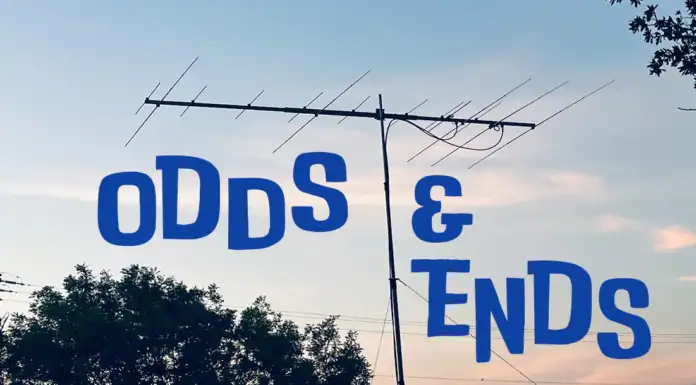





[…] In June 2020 I added a blog post covering all the six meter antennas that I’ve tried over the years along with links to the original blog posts. You can find it at Six Meter Antennas — I’ve Tried a Few. […]
Jim, Great stuff!
In our Alaska VHF-Up Group we tried initiating some seminars/workshops typically at local restaurants until Covus shut that down. I posted links to both RSGB and your webpage on our reflector.
August this year was my first try at wsjt-x:FT8 on 50.313 with 3-elements and 80w with my K3. All I can say is “wow”.
I now have my dual G0KSC 7-element LFA array QRV with 1kW Harris amp. Will be on 6m eme/ms very shortly.
http://www.kl7uw.com/6m.htm
73, Ed – KL7UW
Yep, you’ve tried a few antennas as well. Sure hope to work you on 6 meters. But it will need to be FT8 with some strong Es. No EME array here. Thanks for your comment and good luck on the bands. 73, Jim, K5ND
How’s the PAR Omni working for you? Have you seen the 6m loop at VHFLoops?
Hi Paul, I haven’t used the Par Electronics 6 meter Omni all that much. Right now I’m using a Directive Systems 5-element Yagi and having quite a bit of fun. I’ve looked at what I believe you’re referring to as the VHF Loops at https://www.vhfloop.com/product/6m-f-magnetic-loop/ I’m not familiar with magnetic loops and their characteristics. And apart from SWR and manufacturing, they don’t say much on their website. You may want to look at the Par Electronics description and details about their omni’s at http://www.parelectronics.com/faq-omniangles.php I have their omni-angles for 50, 144, 222, and 432 MHz. They work great. Of course, on 6 when the band is open pretty much anything will work. Pick up the antenna of your choice, get on the air, and have some fun. 73, Jim @ K5ND
Jim, have you tried making the dipole with rigid materials and using it as a rotatable dipole?
Dennis- KA1RUE
Hi Dennis, I haven’t tried that. The Moxon fits in nearly the same space. So I went with that.
Good luck, 73, Jim
[…] 6 Meter Antennas https://kbi.dpx.mybluehost.me/2020/06/six-meter-antennas-ive-tried-a-few/ […]
[…] Six Meter Antennas I’ve Tried a Few — 16% of all pageviews on the site. […]
Hey Jim. 6m loops – are you familiar with the KU4AB square loops? Back in early May 2010 I bought the KU4AB SQ-50, SQ-144 stack and SQ-432 stack so I could operate rover during the 2010 June VHF/UHF contest. I liked how well each bands loop worked that a month later I bought another KU4AB SQ-50, SQ-144 stack and SQ-432 stack for the home QTH. So far I’v confirmed 221 grids on 6m SSB with 100w and SQ-50 single loop at 35’. 41 grids on 2m SSB with 50w and SQ-144 stack loop, top loop at 34’. And 14 grids on 432 SSB with 20w and SQ-432 stack loop, top loop at 33’.
My question is, I dont do much VHF/UHF rover operations like I did between 2010 – 2017. I’d like to take my rover SQ-50 loop and stack it with my QTH SQ-50 loop. If I remember correctly, Phil-KU4AB, had on his website that the SQ-50 stack spacing between the two loops was 12’. Phil no longer makes his KU4AB loops and I have not seen any info regarding the SQ-50 stack loop specs when searching on line. How can I figure out what the proper spacing is for stacking both of my SQ-50 loops. Like I said, I want to say that the spacing is 12’ but don’t quote me on that.
Hi Tim, I searched the Way Back Machine and the info found there agrees with your 12 feet stacking spacing. Here’s the link https://web.archive.org/web/20100501023746/http://ku4ab.com/stackingantennas.html
Good luck and have fun.
Jim, K5ND
I’ve also found this information: Optimum stacking distance is between 5/8 -> 3/4 wavelength and is relatively non critical.
I posted this stacking distance question on a 6m FB group. Someone came back with some good info and said that stacking between 9’ – 12’ will work with 9’ offering a better radiation pattern.
Iv been searching all over the internet for any info I can find for any of the KU4AB 6n / 2m / 432 mhz loops and 90% of what I find is links to E-Ham reviews. Thanks for the link!
Some of the info that the Ham commented with on my post was the specs for the M2 6m halo specs. Iv always assumed that since the antenna is a loop that it has no gain. I was surprised to see that the M2 6m Halo single loop had some gain and how much the gain increased when stacking two loops. Its been so long since I bought all of my KU4AB loops that I don’t remember if the SQ-50 had any gain. Im not sure if this can be answered, but in general, as far as performance, what can I expect with stacking the two loops compared to just the single loop? Right now my QTH SQ-50 is at 35’. When I stack them I will add another 10’ section of 1.25 OD 16 gauge galvanized TV antenna mast which will put the top SQ-50 at 45’ and the bottom SQ-50 around 33’ which will be high enough to get it above the peak of the house roof. I do know that the SQ-50 can handle up to 1kw. Right now all I have with my IC-706MKIIG is 100w. I would like to find a decent 300w – 500w 6m amp. What would you recommend? I know you have a 1,200w amp for 6m. I’m not sure that I need that much power. 300w – 500w or even up to 600w should easily get the job done.
Thanks – Tim – KD5ITM – Spring, Tx – EM20hb
Working DX depends mostly on hearing them. With an omnidirectional antenna, you’re hearing well in all directions. That includes the DX and every source of noise around you. The best first step in working with more DX is to use a better antenna; some sort of directional antenna would be best. Good luck.
Ahh just looked at the link. I see that stacking will give 3 dbi of gain.